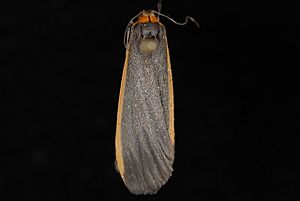Bicolored moth facts for kids
Quick facts for kids Bicolored moth |
|
|---|---|
 |
|
| Scientific classification | |
| Synonyms | |
|
The bicolored moth (scientific name: Manulea bicolor) is a small, interesting moth. It's also sometimes called the yellow-edged footman. This moth belongs to a family called Erebidae. You can find it in the northern parts of North America.
Contents
Discover the Bicolored Moth
Where Does the Bicolored Moth Live?
The bicolored moth lives in the cool, northern regions of North America. This area is called "boreal North America." You can find it from places like Labrador and Massachusetts all the way to Yukon and British Columbia. In the Rocky Mountains, it can be seen as far south as Colorado. These moths like to live in northern forests. They also live in open parklands and near rivers where cottonwood trees grow.
What Does the Bicolored Moth Look Like?
The bicolored moth is quite small. Its front wings are usually about 13 to 17 millimeters long. That's about half an inch! The wings are a dull medium to dark gray color. A cool feature is the bright yellow edge along the front of its forewings. This yellow edge is called the "costa." Adult male moths fly around from July to August. Female moths are "brachypterous." This means their wings are very short and they cannot fly.
What Do Bicolored Moth Larvae Eat?
The young bicolored moths are called larvae, or caterpillars. These larvae mostly eat lichens. Lichens are small plant-like growths that often grow on trees. The larvae especially like lichens found on conifer trees. Conifer trees are trees like pines and firs. Sometimes, if there aren't enough lichens, the larvae might also nibble on the needles of these conifer trees.

